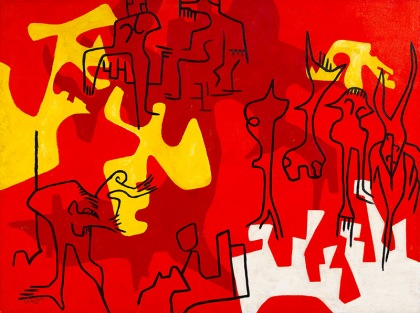Afro Modern
Journeys through the Black Atlantic
Venue: Tate Liverpool, UK
Dates: 29 January to 25 April 2010
Afro Modern: Journeys through the Black Atlantic took place at the Tate Liverpool in 2010 and was ultimately inspired by Paul Gilroy’s seminal book The Black Atlantic: Modernity and Double Consciousness (1993). As the organisers described it, the exhibition identified a hybrid culture that spans the Atlantic, connecting Africa, North and South America, The Caribbean and Europe. It was noted at the time it opened that it was the first major exhibition to trace the deep of influence Black Atlantic culture on modernism and and aimed to reveal how Black artists and intellectuals have played a central role in the formation of modernism from the early twentieth century. It underscored the influences of African art on the modernist forms of artists such as Picasso, as well as the work of contemporary artists such as Kara Walker, Ellen Gallagher and Chris Ofili. In addition, the exhibition mapped out visual and cultural hybridity in modern and contemporary art that has arisen from the journeys made by people of Black African descent. Divided into seven chronological chapters, from early twentieth century avant-garde movements such as the Harlem Renaissance to debates around ‘Post-Black’ art, this exhibition strove to open up an alternative transatlantic reading of modernism and its impact on contemporary culture for a new generation.

Uche Okeke. Ana Mmuo 1961. Gift of Joanne B. Eicher and Cynthia, Carolyn Ngozi, and Diana Eicher. National Museum of African Art, Smithsonian Institution

Uche Okeke. Ana Mmuo 1961. Gift of Joanne B. Eicher and Cynthia, Carolyn Ngozi, and Diana Eicher. National Museum of African Art, Smithsonian Institution
Afro Modern
Journeys through the Black Atlantic
Venue: Tate Liverpool, UK
Dates: 29 January to 25 April 2010
Afro Modern: Journeys through the Black Atlantic took place at the Tate Liverpool in 2010 and was ultimately inspired by Paul Gilroy’s seminal book The Black Atlantic: Modernity and Double Consciousness (1993). As the organisers described it, the exhibition identified a hybrid culture that spans the Atlantic, connecting Africa, North and South America, The Caribbean and Europe. It was, at the time, the first to trace the deep of influence Black Atlantic culture on modernism and and aimed to reveal how Black artists and intellectuals have played a central role in the formation of modernism from the early twentieth century. It underscored the influences of African art on the modernist forms of artists such as Picasso, as well as the work of contemporary artists such as Kara Walker, Ellen Gallagher and Chris Ofili. In addition, the exhibition mapped out visual and cultural hybridity in modern and contemporary art that has arisen from the journeys made by people of Black African descent. Divided into seven chronological chapters, from early twentieth century avant-garde movements such as the Harlem Renaissance to debates around ‘Post-Black’ art, this exhibition strove to open up an alternative transatlantic reading of modernism and its impact on contemporary culture for a new generation.
